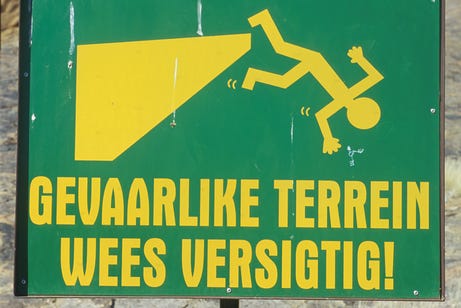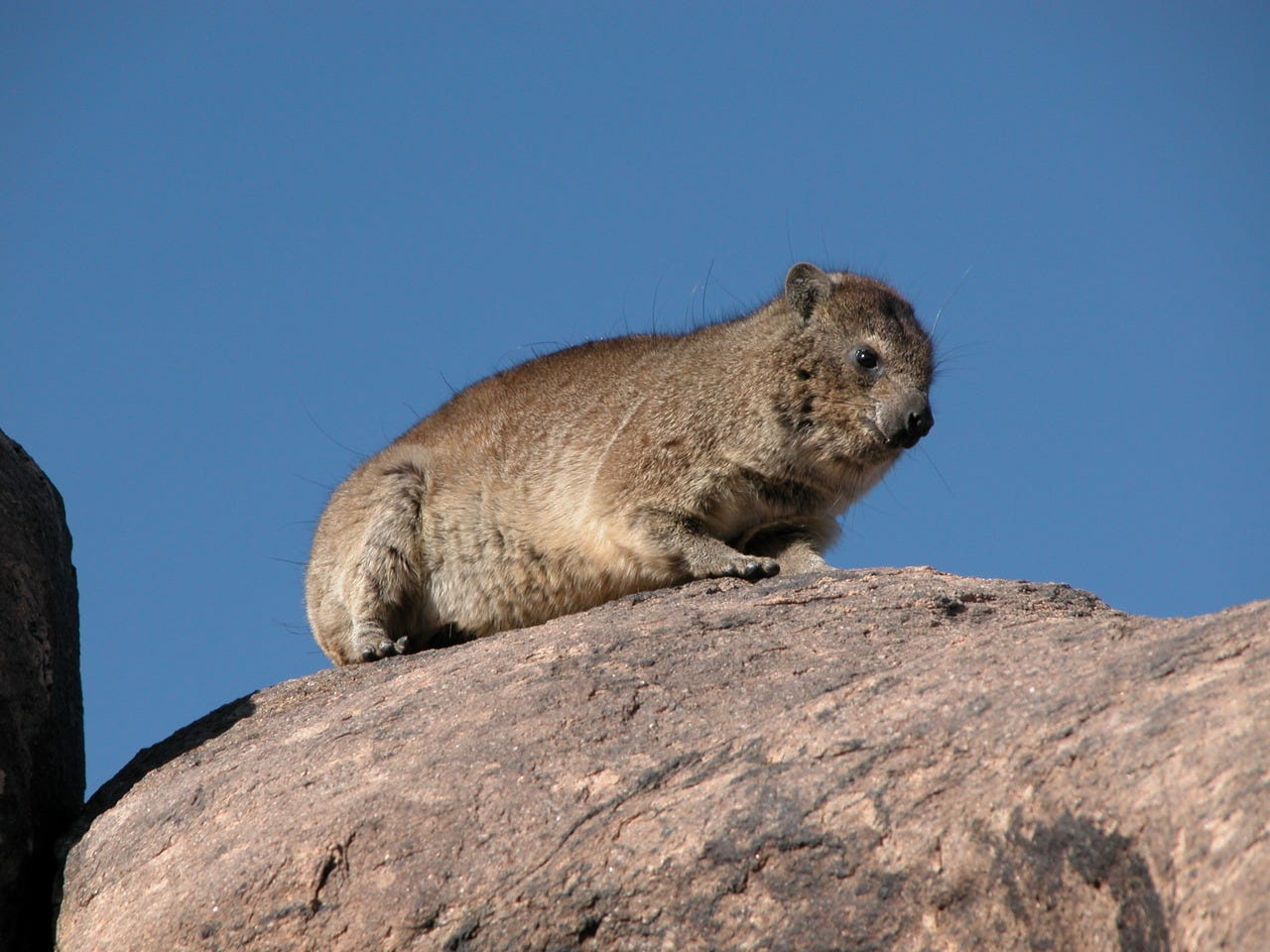The most beautiful place on the Earth
And to get there only requires taking one death defying leap!
There is a place in South Africa where a major river splits into numerous channels, one large, and several small. It does this because there is almost no sediment in the river valley, just rock, as is the case of much of South Africa, so when the river floods, the water just spreads out everywhere and can’t really change the channels around like rivers with soft mushy floodplains do. So, over the course of about 800 million years, the flooding river spread and found ancient “joints” — linear weak spots in the granite — and turned them into channels, and some of those channels have grown quite large.
As a result, the river splits into multiple usually dry channels, but then every different channel eventually joins back in to the main river somewhere, and each joining place resembles from the sky an arrowhead pointing down stream. Since this occurs at the site of an ancient step in the landscape, with a huge waterfall, each arrowhead is poised far above the main channel, atop cliffs that are hundreds of feet high.
One of these arrowheads has a path leading from a small camping area, through a snake infested marsh, then along the rocky divide out towards the tip. As one approaches the tip, there is a beat up old sign that tells you to stop, turn around, and go back. Do not pass beyond that point. Too dangerous. A few dozen meters after that sign (you did not turn around) there is a large rounded sloping final boulder, the end of the place you can walk safely. You can walk a certain distance out on that boulder before it becomes too steep to stand, and if you slip, you fall into a crevasse that is dozens of meters deep, and you would die there. But if instead of falling to your death, you run up to the edge of the rock and leap across the crevasse, you might land on the next rounded sloping boulder, gain your balance, and then you get to walk a little farther along the arrowhead. When you have done this, you will have arrived at the most beautiful place on this planet.
The amazing red and orange rocks of the cliffs around you are divided between granular and rough vs shiny, depending on the geology. At a few points along the cliffs emerald waterfalls cascade down into hanging ponds, then out of the ponds and down to the river. The river below is a broad expanse of every size rock from small house-size boulder to gravel. The exposed ancient bedrock is festooned here and there with a variety of plant life. There are said to be plants down in that valley that only exist there, species and subspecies only found in this oasis of water surrounded by hard scrabble desert hundreds of kilometers in every direction.
If you look carefully, small greenish brown creatures may be seen on some of the distant rocky areas, sitting or moving in small groups. These are baboons. On further inspection, smaller greyish-brown creatures will be seen sunning themselves. Thy are the dassies, and once your eyes catch a few of them, you will see hundreds. There will probably be a dassie-eating Marshal eagle or two out hunting, and lots of other wildlife as well. There will probably be zero people other than you and whom you are with.
But that’s not what I wanted to tell you about. I want to focus instead on the part where you take what became known to my small community of friends and colleagues as “The Leap of Death.” I’ve taken the leap myself countless times, and I’ve watched others do it as well, and there is something strange about it. Everyone who does it lifts off from the first boulder at almost exactly the same place, on the last place you can put your food safely. Then they fly through the air and their other foot lands on the next boulder in the same place as everyone else who has ever made the leap in my observation. Most of the people I’ve seen do it are women, ranging from just over 5 feet to just under 6 feet in height, from non-athletic to super-athlete. I’m probably the tallest person I’ve seen do it, and the shortest person is nearly a foot shorter than I. But everyone takes the same exact distance to leave boulder one to arrive at boulder two. You would think the taller people with longer legs, especially my very tall friend who is a high performance athlete, would go farther than everyone else, but they do not.
And I think this is a little like how learning can be.
Let’s take the Krebs and Cavlin cycles as an example. These are two complex sets of chemical interactions that have to do with the main energy pathways in plants and animals, roughly equivalent to photosynthesis and respiration. If one learns about these systems in an advanced high school class, one learns about a minimum of 10 different chemical steps operating at the center each, and another dozen or so steps that link these cycles to the rest of the lifey stuff that is happening inside cells. That’s complicated, and hard to learn, but once you’ve learned it, you understand how life works. Right?
Yes, at some level, but no at many other levels. At the broader level, consider this question. If the Calvin and Krebs cycles, and the details that go with them, cover the basics of making sunlight into energy and using that energy in plants and animals, then that information should give us the answer to the following simple question:
When you breath out a bunch of CO2 molecules, where did those Carbon atoms come from originally? What molecules were those carbon atoms part of previously, and then, prior to that, what atoms were they attached to over the previous several dozen iterations (skipping the multiple steps inside the aforementioned cycles)? Putting it a slightly different way, we know that the Carbon in the CO2 we breathe out was once CO2 “breathed in” by something else that was alive. What was that journey from then to now like, at any level of detail? Most people can’t answer that question. Even biology experts who don’t specifically study certain specific things may be unusre of the answer unless they happen to have pondered it recently and asked Alexa or Google about it. There was a recent paper exploring this that got some press, so I’d guess a lot of biology nerds will have an answer. But most students learning advanced biology in high school won’t be able to give a definitive answer, or even a rough guess. And it won’t matter because that is not going to be on the test.
(And I find this weird, because I would have thought that asking where the molecules you are spewing out of your body under normal operation came from could be a great starting point for teaching biology.)
Let’s look at these biological cycles at a different scale. I won’t be able to formulate sensible questions, let alone provide any kind of answer to this, but as I understand it, in order to truly describe what is going on with the multiple chemical steps at the smallest spatial scale, one has to engage in quantum mechanical thinking. Here is how I know this. I’m told that if you produce a room, even a large room, with absolutely nothing whatsoever in that room — absolutely nothing — then put one electron in the middle of that room, that the electron is then, in effect, everywhere in that room.
But in the photosynthetic cycle, and all the other bio-chemical processes happening, it is the very specific interaction of very specific alleged electrons with other subatomic thingies that allow/cause/result form these chemical steps. I’m told that there may in fact be only on electron in the universe, that the math of quantum mechanics either allows this or perhaps requires it, yet all the life on this planet involves countless precise interactions of alleged specific and presumably individual electrons and other subatomic particles. How the heck does that work?
Clearly, there is more to life than what we normally learn when we learn about life.
The step across the crevasse is exactly how far it needs to be, not more or not less, to safely sail to the tip of the arrowhead. Roygbiv, my very educated mother just served us nachos, dear king phillip came over for good spaghetti, and the highly processual citrate is krebs starting substrate for making oxaloacetate (citrate), and all the other frameworks of learning and knowing about life are that leap. Just that leap. Just enough, not too little, not to much. Knowledge that we learn is learned in chapters, but life about which we learn has no first and last paragraph (though there might be helpful illustrations).
That might sound a little depressing, that learning is a limited and perhaps limiting experience that just does the job but no more. That may be true, but learning a thing, and taking the Leap of Death, are also steps (sometimes literally) to arrive at the most beautiful place on earth. In the case of my river in South Africa, one arrives then one starts to ask questions about things, those moving greenish blobs, those plant, those birds, that geology. In the case of learning about life, or physics, or political science, one also arrives at a place where there are questions, often many questions, the primary one being: “What’s next?”
So, what’s next?








Need more pictures.